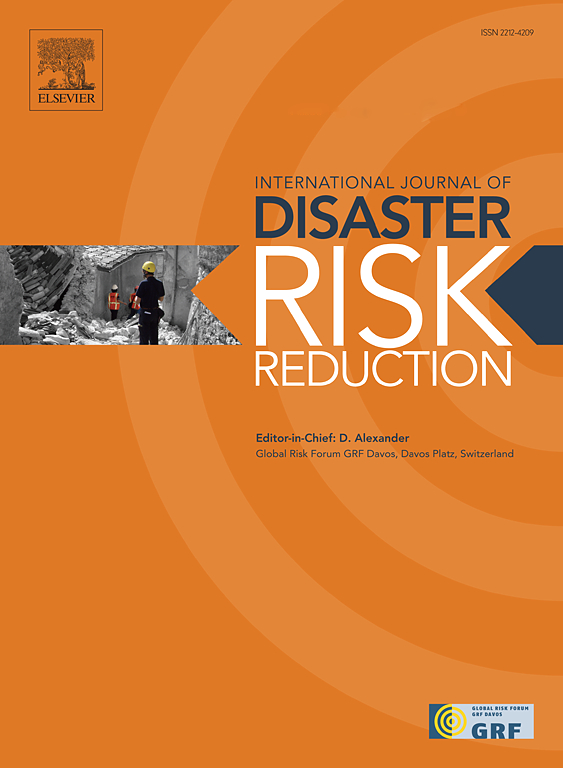在怀疑与解决方案之间:尼泊尔救灾现金援助的制度化
IF 4.5
1区 地球科学
Q1 GEOSCIENCES, MULTIDISCIPLINARY
International journal of disaster risk reduction
Pub Date : 2025-07-12
DOI:10.1016/j.ijdrr.2025.105699
引用次数: 0
摘要
本案例研究基于对自2015年地震以来在尼泊尔从事现金和代金券援助(CVA)的17名人道主义从业人员的访谈,探讨了现金规划在支持尼泊尔灾后家庭恢复方面的有效性。我们将这种演变与不同的人道主义援助理论结合起来,展示尼泊尔的理论和实践是如何随着时间的推移而变化的。研究发现,尽管面临挑战,但人们认为现金方案比传统援助更有效,因为它能够赋予受援国权力,提高透明度,减少行政负担。确定的主要挑战包括政府怀疑、利益相关者协调有限以及金融普惠的障碍。该研究还重点介绍了尼泊尔现金规划从应急响应到发展规划的演变,从现金信封转向数字技术。该研究强调需要加强国家一级的减少灾害风险和管理框架,以提高灾害恢复中现金方案的有效性。报告建议投资于预期行动,促进政府的大力支持,并制定强有力的体制框架,以最大限度地发挥现金方案作为恢复工具的潜力。通过吸取尼泊尔的经验教训,研究结果为其他在灾后恢复方面面临类似挑战的国家提供了可操作的见解,并提供了更好地利用现金转移支付建设复原力和有效应对灾害的战略。最终,本研究通过说明现金规划如何逐步塑造尼泊尔的灾害应对格局,为其在国家系统和更广泛的人道主义发展联系中长期整合的潜力提供了重要见解,从而为人道主义学术做出了贡献。本文章由计算机程序翻译,如有差异,请以英文原文为准。
Between skepticism and solutions: The institutionalization of cash assistance in Nepal's disaster response
This case study examines the effectiveness of cash programming in supporting the recovery of Nepali households after disasters, based on interviews with 17 humanitarian practitioners experienced in cash and voucher assistance (CVA) in Nepal since the 2015 earthquakes. We align this evolution with different humanitarian aid theories to showcase how theory and practice have changed over time in Nepal. The study found that, despite facing challenges, cash programming was perceived as more efficient and effective than traditional aid due to its ability to empower recipients, enhance transparency, and reduce administrative burdens. Key challenges identified include government skepticism, limited stakeholder coordination, and barriers to financial inclusion. The study also spotlights the evolution of cash programming in Nepal from emergency response to development programming with a shift from cash envelopes to digital technologies. The study highlights the need to strengthen national-level disaster risk reduction and management frameworks to improve the effectiveness of cash programming in disaster recovery. It recommends investing in anticipatory action, fostering strong government support, and developing robust institutional frameworks to maximize the potential of cash programming as a recovery tool. By drawing on lessons learned from Nepal, the findings provide actionable insights for other countries facing similar challenges in disaster recovery offering strategies to better utilize cash transfers in building resilience and responding to disasters effectively. Ultimately, this study contributes to humanitarian scholarship by illustrating how cash programming is progressively shaping Nepal's disaster response landscape, offering critical insights into its potential for long-term integration within national systems and the broader humanitarian-development nexus.
求助全文
通过发布文献求助,成功后即可免费获取论文全文。
去求助
来源期刊

International journal of disaster risk reduction
GEOSCIENCES, MULTIDISCIPLINARYMETEOROLOGY-METEOROLOGY & ATMOSPHERIC SCIENCES
CiteScore
8.70
自引率
18.00%
发文量
688
审稿时长
79 days
期刊介绍:
The International Journal of Disaster Risk Reduction (IJDRR) is the journal for researchers, policymakers and practitioners across diverse disciplines: earth sciences and their implications; environmental sciences; engineering; urban studies; geography; and the social sciences. IJDRR publishes fundamental and applied research, critical reviews, policy papers and case studies with a particular focus on multi-disciplinary research that aims to reduce the impact of natural, technological, social and intentional disasters. IJDRR stimulates exchange of ideas and knowledge transfer on disaster research, mitigation, adaptation, prevention and risk reduction at all geographical scales: local, national and international.
Key topics:-
-multifaceted disaster and cascading disasters
-the development of disaster risk reduction strategies and techniques
-discussion and development of effective warning and educational systems for risk management at all levels
-disasters associated with climate change
-vulnerability analysis and vulnerability trends
-emerging risks
-resilience against disasters.
The journal particularly encourages papers that approach risk from a multi-disciplinary perspective.
 求助内容:
求助内容: 应助结果提醒方式:
应助结果提醒方式:


